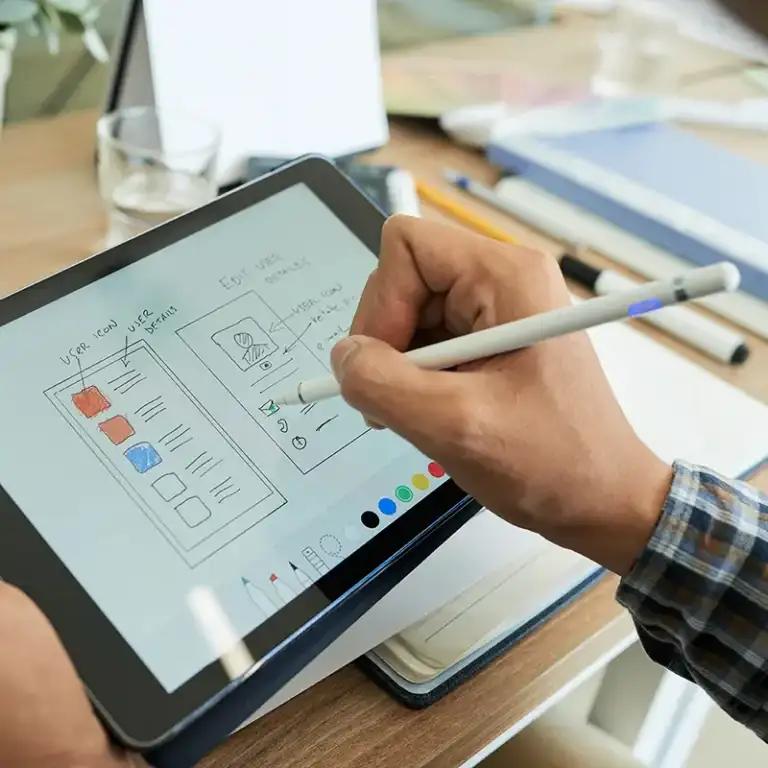
Much like a chameleon, the mobile app industry is well-known for its ability to adapt swiftly to its ever-evolving digital surroundings. Driven by continuous advancements in new technologies, evolving user demands, and an insatiable appetite for superior user experiences, the trajectory of mobile app design trends is ceaselessly forward. With that said, let’s delve into some key trends and innovations currently shaping the mobile app design landscape.
10 Interesting Design Trends
1. Minimalist Design: Less is More in Mobile App Design Trends
Firstly, simplicity is a new luxury in the chaos of digital information overload. The world of app design is embracing the minimalist trend, focusing on clean lines and reduced elements. The aim is to offer users a seamless experience free from clutter and confusion. When appropriately implemented, minimalist design can help users navigate the app quickly and perform desired actions faster.
2. Embrace the Dark Side: Dark Mode
Moving on, in the wake of system-wide dark modes introduced by Apple and Android, a significant shift in app design trends has occurred. Apps now include dark mode compatibility to align with device settings, providing users with a more unified and visually comfortable experience.
3. Say it Out Loud: Voice User Interface (VUI)
As we continue to explore, another significant trend is the rising popularity of voice assistants like Siri, Alexa, and Google Assistant. Integrating Voice User Interfaces (VUI) into app designs is becoming increasingly standard, providing hands-free navigation and accessibility.
4. The Little Things: Microinteractions
Subtle animations that respond to user actions, known as micro-interactions, play a crucial role in enhancing user engagement. These tiny design elements provide immediate feedback, helping users understand the app’s response to their actions and making the overall experience more satisfying.
5. Reality, but Better: Augmented Reality (AR)
Thanks to technologies like ARKit and ARCore, Augmented Reality is no longer confined to sci-fi movies. More apps are beginning to incorporate AR elements into their design, offering users a more immersive and interactive experience.
6. Soft and Subtle: Neumorphism
Furthermore, metamorphism, a design trend characterized by mimicking physical objects with a soft, 3D aesthetic, is gaining traction. Designers can use subtle shadows and highlights to create elements that seem to extrude from the background, adding depth to the overall design.
7. Into the Third Dimension: Animated and 3D Graphics – another Mobile App Design Trend
Animation and 3D graphics are being used to bring life to otherwise static app screens. These elements can help create a unique and immersive user experience, making your app stand out in the crowded marketplace.
8. Secure and Personal: Biometrics
In an era of growing digital threats, biometric authentication represents a significant trend. App designs integrate fingerprint scanning or facial recognition technologies for increased security and ease of access.
9. The Power of AI and Machine Learning is a Mobile App Design Trend
Subsequently, the influence of Artificial Intelligence (AI) and Machine Learning (ML) is felt in app design. These technologies enable apps to learn from user behavior and provide a more personalized experience.
10. A Gesture Speaks a Thousand Words: Gesture-based Navigation
As screen sizes grow and bezels shrink, gestures have become the go-to method for navigation within apps. Gesture-based navigation offers a more immersive and intuitive user experience, aligning with the natural way users interact with their devices.
In conclusion, these trends highlight the current direction of mobile app design – focusing on user experience, engagement, and security, all while leveraging the power of emerging technologies. As we move forward, it will be exciting to see how these trends evolve and what new trends will emerge to shape the future of mobile app design. Talk to us about unveiling the Future with top Mobile App Design Trends Shaping 2023.
Need help with your project?
Book a free 30-minute consultation with our developers. No strings attached.